

Free Excel Training! Organizations need to embrace ‘spend optimisation’ They can become empowered to not only cut their costs but also enhance profitability Enterprises are increasingly coming under pressure to make valuable use of their available resources, yet a complaint I hear time and time again is that different departments across the organisation are failing to collaborate on spending.
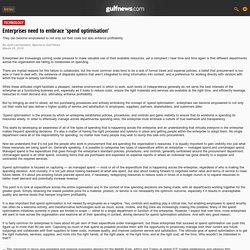
There are myriad reasons for this failure to collaborate, but the most common ones tend to be a lack of formal travel and expense policies, a belief that procurement is too slow or hard to deal with, the existence of disparate systems that aren’t integrated to bring information into context, and a preference for working directly with vendors with which the buyer is already comfortable.
‘Spend optimisation’ is the process by which an enterprise establishes policies, procedures, and controls and gains visibility to ensure that its workforce is spending its resources wisely. It is also important that spend optimisation is not viewed by employees as a negative. Creating a Culture of Spend Optimization. Executive Outcome Assessment. Details Published: 02 August 2009 Hits: 8960 Find how the organization you lead, or may lead, will fare under your leadership!
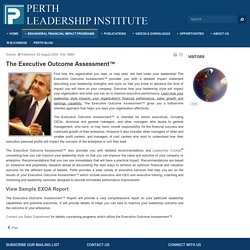
The Executive Outcome Assessment™ provides you with a detailed impact statement describing your leadership strengths and style so that you know in advance the kind of impact you will have on your company. Perth Leadership Institute - Financial Signature Program. Details Published: 02 August 2009 Hits: 9498 The Financial Signature® Program We are all hardwired in certain ways such that we all have characteristic biases that impact our decisions.

This is the province of behavioral finance. Perth Leadership Institute - Home. Managerial Accounting for Managers. The Essentials of Finance & Accounting for Non-Financial Managers. Fundamentals of Financial Management. Accounting and Business - Free Management Video Lectures. Learn Accounting Online for Free. For managers & professionals. Book How to Use Financial Statements.
Business Financial Management. PPT - Finance & Accounting for Non-Financial Managers. Best Selling Financial Intelligence Books - Business Literacy Institute Financial Intelligence. “On any given subject, it’s safe to say that most people don’t know what they’re talking about.

That goes double for finance and accounting.” Accounting Today “CFOs who want to promote financial literacy among the non-financial managers they work with might consider recommending this book. It reads easily without dumbing down, AND it’s comprehensive.” — CFO.com. Financial Management - Nonprofit Resource Center. Understanding Accounts - Basic Finance for Non-Financial Managers - Career Development from MindTools. Basic Finance for Non-Financial Managers Knowing your way around a spreadsheet can help your career. © iStockphoto/leventince It's not just accountancy specialists who deal with spreadsheets, and figures, and the financial side of business.
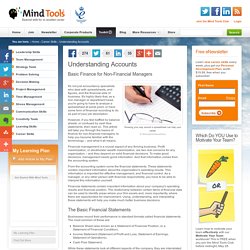
It's highly likely that, as a line manager or department head, you're going to have to analyze a spreadsheet at some point, or have some form of financial recording to do as part of your job description. However, if you feel baffled by balance sheets, or confused by cash flow statements, then read on. Analyzing Financial Statements. This topic could be and is a full semester course at some business schools.
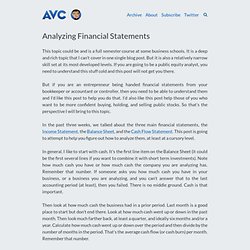
It is a deep and rich topic that I can’t cover in one single blog post. But it is also a relatively narrow skill set at its most developed levels. If you are going to be a public equity analyst, you need to understand this stuff cold and this post will not get you there. But if you are an entrepreneur being handed financial statements from your bookkeeper or accountant or controller, then you need to be able to understand them and I’d like this post to help you do that. I’d also like this post help those of you who want to be more confident buying, holding, and selling public stocks. In the past three weeks, we talked about the three main financial statements, the Income Statement, the Balance Sheet, and the Cash Flow Statement.
In general, I like to start with cash. Then look at how much cash the business had in a prior period. If cash flow is positive for all periods, then you are done with cash. AICPA Financial Literacy Resource Center. Presenting Financial Information Visually in PowerPoint – Hands-on Tools and Techniques. You regularly present financial information such as monthly results, weekly performance against goals, or financial analysis.

Your slides are full of spreadsheets and complex graphs from Excel. Your audience, whether they are executives or investors, are overwhelmed with the information you present and they end up asking lots of questions. You usually have to do more analysis before they will make a decision. You figure there has to be a better way to present financial information so it is easily understood and acted on.
There is. Use visuals instead of spreadsheets Instead of those slides full of numbers and complex graphs, you should be using visuals such as proportional object collections, grouped item comparisons, tables of insights, clear graphs, and many more like these: How to Talk About Finances So Non-Financial Folks Will Listen. Building Leadership Nonprofit staff members almost universally understand the importance of achieving the mission of the organization and are trained in delivering direct services such as feeding the hungry, educating low-income children, or advocating for a more sustainable environment.
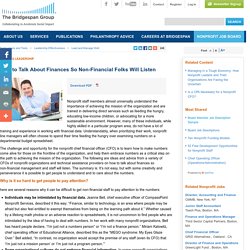
However, many of these individuals, while highly skilled in a particular program area, do not have a lot of training and experience in working with financial data. Understandably, when prioritizing their work, nonprofit line managers will often choose to spend their time feeding the hungry over examining numbers on a departmental budget spreadsheet. The challenge and opportunity for the nonprofit chief financial officer (CFO) is to learn how to make numbers come alive for those on the frontline of the organization, and help them embrace numbers as a critical step on the path to achieving the mission of the organization.